A Most Amazing Restoration I Have Yet to See…


The Miquon Creek Steam Restoration Project is today’s topic in honor of the recently celebrated Earth Day.
I learned about this project in a presentation by water resources engineering firm Biohabitats at “Engineering Green Maryland” last November in Baltimore. With permission from the school, Biohabitats’ Brett Long, P.E., shared information and images from his presentation.
The Miquon School, an independent founded in 1932, is located in Conshohocken, PA, an old mill town situated along the Schuylkill River in suburban Philadelphia. The name is derived from an Algonquin language and means either “elegant-ground-place” or “large-bowl-ground-place.” (courtesy Wikipedia.)
The school’s mission is Progressive Education for pre-K through 6th grade. Progressive education embraces 9 tenets. “The natural world is a place to learn” is one of ’em. In the recent years, Miquon has expanded its mission by adopting the SEED (Seeking Educational Equity and Diversity) program which training of teachers and staff impacts classroom discussions, curriculum development, and educational activities across the grades.
To fund the stream restoration project, a $95k grant from the PA Department of Environmental Protection’s “Growing Greener” program was won. Another $71k was raised from school and camp families, alumni, staff and a small host of other contributors.
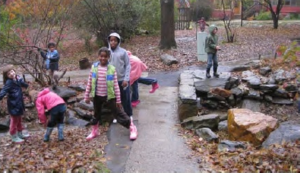
 The project is located in the southerly end of the Schuylkill River Watershed. Here are images of the creek both under normal conditions and during a 2009 storm. (Note the vertical utility box in the background, verifying same location for the comparative photos.)
The project is located in the southerly end of the Schuylkill River Watershed. Here are images of the creek both under normal conditions and during a 2009 storm. (Note the vertical utility box in the background, verifying same location for the comparative photos.)
 Down-cutting into an existing stream channel, called stream incision¹, may be seen in the pix right showing high channel embankments. What causes stream incision is watershed hydrology–runoff amount and duration following a storm–where the stream channel and adjacent floodplain come out of balance with one another.² One source of imbalance is flash flooding, or heavy storm flow events which in turn can cause stream bank riparian buffers³ to be lost through failing vegetation.
Down-cutting into an existing stream channel, called stream incision¹, may be seen in the pix right showing high channel embankments. What causes stream incision is watershed hydrology–runoff amount and duration following a storm–where the stream channel and adjacent floodplain come out of balance with one another.² One source of imbalance is flash flooding, or heavy storm flow events which in turn can cause stream bank riparian buffers³ to be lost through failing vegetation.
What adds to potential stream erosion is increasing average total annual precipitation and more extreme storms.
Healthy stream beds are ones where the water level is nearly even with the surrounding land (floodplain). This is more likely when the impervious cover in the watershed is a lower rather than higher percentage of total land. Too much impervious cover lessens ground absorption of rainwater, typically resulting in increasing flow rate with accumulating sediment headed to a river or stream embankment. This stimulates prospects for eroded streams, or stream incisions, in the watershed.
 Biohabitats’ project manager advised the school that repair strategies include: pond retrofits; infiltration/sand berms; stream restoration; regenerative stormwater conveyance; and, bioretention. Examples of previously completed projects employing certain of these strategies are show in 3 before/after pix adjacent.
Biohabitats’ project manager advised the school that repair strategies include: pond retrofits; infiltration/sand berms; stream restoration; regenerative stormwater conveyance; and, bioretention. Examples of previously completed projects employing certain of these strategies are show in 3 before/after pix adjacent.
Miquon selected stream restoration since it was the most feasible option to immediately address watershed hydrology effects on its property. Adopting stream restoration strategies would:
- eliminate hazards for recreation near the stream
- provide water quality improvement
- lead to aquatic and terrestrial habitat improvements
- increase habitat diversity, and
- improve groundwater recharge
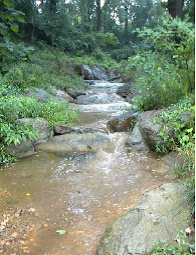
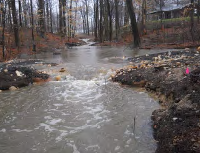 Of the stream restoration strategies, one involved building in-stream structures such as riffles (raised stream bed “bridges” as in the first pix adjacent) and boulder cascades.
Of the stream restoration strategies, one involved building in-stream structures such as riffles (raised stream bed “bridges” as in the first pix adjacent) and boulder cascades.
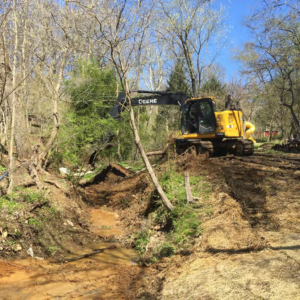
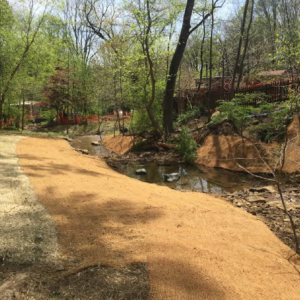
This plan took 4 years to accomplish. From watershed assessment, concept evaluation, funding acquisition, design and multiple permits through construction. (One permit was for a Wetland and Bog Turtle Assessment.)
The recommended restoration strategies were synced with the school’s curriculum. Biology, ecology, botany, hydrology, math, etc. Even art. One related student project is something called Bioblitz!, a National Park Service program. Another is the Leaf Pack Network, an initiative of the Stroud Water Research Center.
 In this belated Earth Day 2017 paean, hats off to Miquon School staff and students, project funders and the impressive work of the Biohabitats pros!
In this belated Earth Day 2017 paean, hats off to Miquon School staff and students, project funders and the impressive work of the Biohabitats pros!
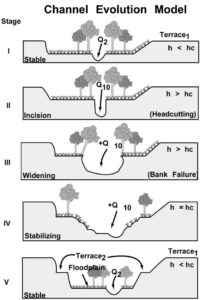 ¹ Steam incision is further defined by stream bed embankments becoming two or more times higher than the stream “bankfull” (normal water level in the stream).
¹ Steam incision is further defined by stream bed embankments becoming two or more times higher than the stream “bankfull” (normal water level in the stream).
² Perhaps this Channel Evolution model illustration helps?
³ Riparian buffers are vegetated areas that help shade and partially protect streams from adjacent land use impacts.